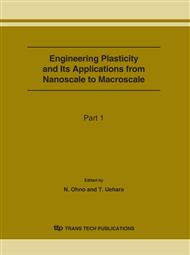p.143
p.149
p.155
p.161
p.167
p.173
p.179
p.187
p.193
Evaluation of the Interfacial Properties in Polymer Matrix Composite: Experiments and Elasto-Plastic Shear-Lag Analysis
Abstract:
An energy-based analysis has been developed to evaluate interfacial adhesion between fiber and matrix in a single fiber composite over the years. However, the value of the energy-based parameter, e.g. an energy release rate, depends on a stress distribution predicted by a model employed. In the case of carbon fiber-reinforced plastics (CFRP), laser Raman spectroscopy (LRS) is significantly effective to validate the stress distribution predicted. The fragmentation tests with a model of carbon fiber-reinforced epoxy composite are performed, and LRS is used to detect a distribution of the fiber axial strain. An elasto-plastic shear-lag analysis methodology is employed, and a stress distribution is predicted under various approximations of s-s curve of the matrix resin and compared with the experimental results. Our recent energy-balance method, including an energy dissipation induced by plastic deformation around an interfacial debonding tip, is used to calculate an energy release rate to initiate an interfacial debonding (interfacial energy). An effect of the difference between the approximations on the value of the interfacial energy is discussed.
Info:
Periodical:
Pages:
167-172
Citation:
Online since:
June 2007
Authors:
Price:
Сopyright:
© 2007 Trans Tech Publications Ltd. All Rights Reserved
Share:
Citation:


